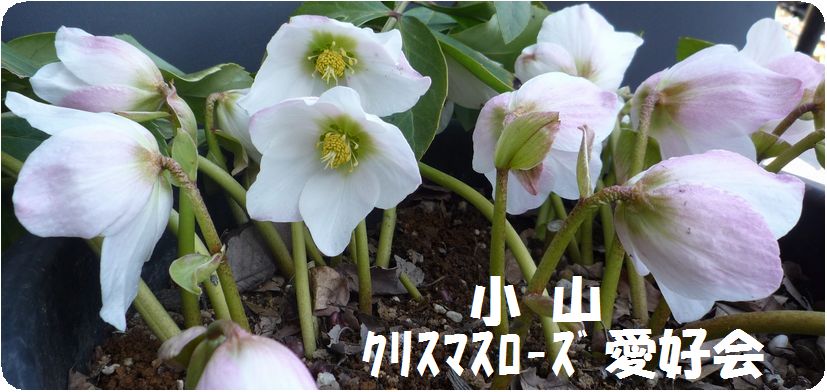A. General
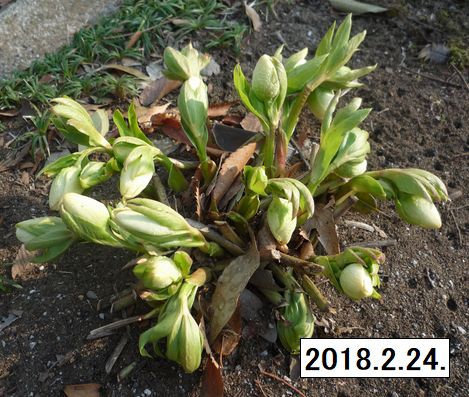
1. What kind of plant is the Christmasrose ?
Christmasrose is a perennial plant that loves the dry and cool season
like late autumn. Its thick roots extend deep underground, so it is
resistant to dryness and can withstand a lot of cold.
In other words, Christmasrose hate damp, hot weather to death.
2. When is the growing season of Christmasrose ?
The growth period for Christmas roses is from mid-September to late May
of the following year, and flowering continues from early March to mid-April.
After flowering season, new leaves grow vigorously from the base of plant.
Fertilizer, water, and sunlight are necessary during the growing period,
but during the dormant period, fertilizer is strictly prohibited,
water is reduced as much as possible, and direct sunlight is avoided.
3. Can it be propagated by cuttings or division ?
Cuttings are not possible. Dividing is possible if it is a large potted
plant that has been grown for more than 5 years, but it does not work
as well as you thought, so I do not recommend it. Propagation by seeds is
recommended.
4. When is the best time to see the flowers ?
Flowering lasts from the beginning of March to the middle of April, but
the characteristics of flowers are best expressed for about a week
after the beginning of flowering.
It continues to bloom after that, but what looks like petals are actually
calyxes (deformed leaves), so they never fall off.
The inner petals of the double flower are not sepals, but deformed
original flowers and stamens, and often fall off after a while.
B. Place of planting or planted pot
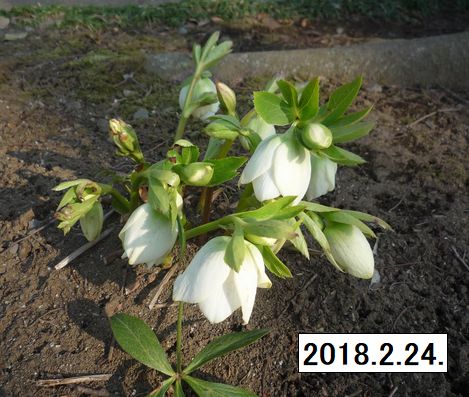
1. Where should I put (plant) the plants ?
The best place to grow them is shade in the summer and full sun in the
winter. A place that gets a lot of sunlight during the winter (growing
period), such as under a deciduous tree, is best.
If the place is exposed to direct sunlight or high temperatures in summer,
We will take measures to avoid the heat, such as blocking light and
improving ventilation.
Do not place potted plants directly on the ground (especially on concrete)
to improve ventilation at the bottom of the pot. Make a gap in the bottom
of the pot with blocks etc.
Throughout the year, be careful not to expose it to the western sunshine,
which emits a lot of infrared rays. Most plants hate the afternoon sunshine.
On the contrary, the morning sunshine, which has a lot of ultraviolet rays,
is good for plants, and also animals.
2. Which Is better to plant in a pot or in the ground ?
If the growing environment is good, planting in the ground is best.
Potted plants are difficult to manage moisture (watering) because the
growth environment of the underground part is restricted.
C. Watering
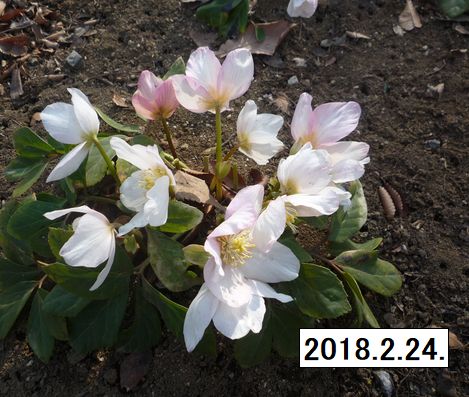
1. When should I water?
WaWatering is done in the morning during the growing season (October -
May). When the topsoil of the pot is completely dry (when the leaves
start to wilt), the potted plants should be generously planted.
Plants in the ground need only natural rain.
Potted plants require more moisture than usual when new leaves appear in
spring (partialy in autumn), but even if the new leaves have enough moisture,
they may wilt even at high temperatures, so be careful when watering.
2. How should I water during the dormant period (July-September) ?
Watering in the summer (July - September) is done in the evening.
It is important to water at intervals, keep it dry, and prevent root rot.
Watering the leaves alone is also effective.
D. Potting soil and repotting
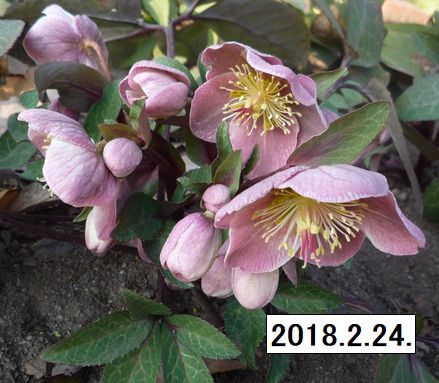
1. What kind of potting soil is better ?
Growing roots actively respire by absorbing oxygen from the air in the
soil interstices.
Poorly-drained soil with few gaps in the soil, where old water remains
stagnant and does not dry out, prevents the supply of oxygen and causes
root rot. It needs repotting before this happens.
The key to potted plants is to use well-drained, water-retaining soil.
Mix 6 pieces of Akadama soil, 3 pieces of mature humus, 1 piece of
pumice stone, and a little fertilizer. Use a deep, well-ventilated pot
with many holes in the bottom (such as a chrysanthemum pot).
2. Should I need to repot every year ?
It is not recommended to repot plants that have been planted in the ground.
Young seedlings grow quickly, so twice a year, in September and March,
they are replanted into pots that are one size larger. 3-year-old potted
plants should be replanted once a year, and 4-year-old or older plants
should be replanted once every two years.
Remove about half of the old soil and carefully remove the rotten black
roots before replanting in new soil.
If the roots are twisted and hardened, after removing the pot, lay the
root ball on its side and press down from above while rolling the roots.
Do not force the roots to spread and damage them.
E. Fertilizer
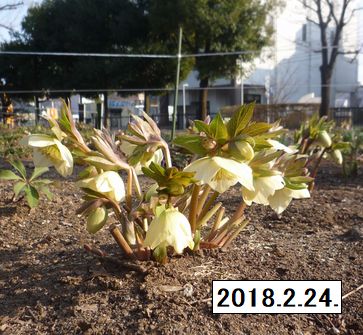
1. What kind of fertilizer is there ?
The three main components of fertilizer are nitrogen, phosphoric acid,
and potassium. Nitrogen nourishes leaves and stems, phosphoric acid
nourishes flowers and fruits, and potassium nourishes roots.
Fertilizers include organic fertilizers and chemical fertilizers. Organic
fertilizers, such as rapeseed meal, bone meal, and poultry manure, work
after they are decomposed by microorganisms, so they are not very
effective at first and work slowly over a period of 1-2 months.
2. What kind of fertilizer, when and how much should I apply ?
Fertilize only when the plant is growing .
Plants will not grow without fertilizer, but too much will damage the
roots and die.
A good way to apply fertilizer is to apply it little by little.
Be careful not to overdo it.
For Christmasroses, fertilize "solid oil cake" in spring and autumn.
(about 2 in a 18cm pot, 3 in a 21cm pot, and 4 in a 24cm pot.
Fast-acting fertilizers such as chemical fertilizers should not be used
except for seedlings.
F. Other cultivation management
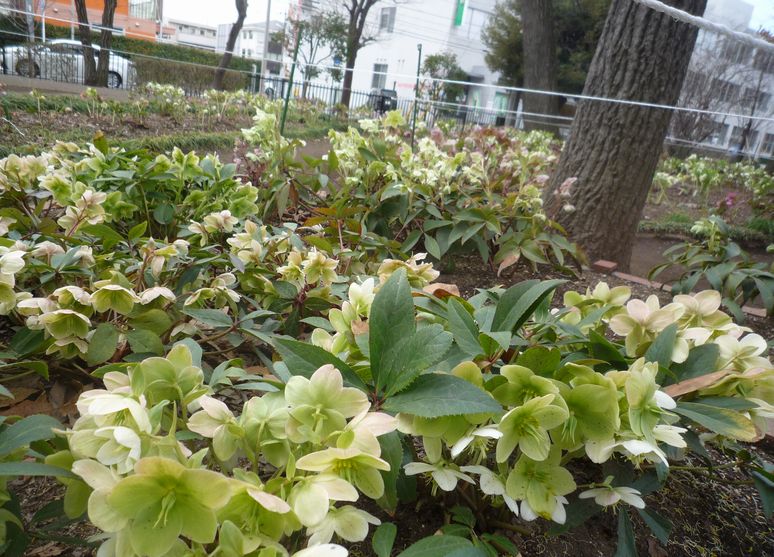
1. When is the best time to cut the leaves ?
In April, young leaves grow vigorously all at once from the growing point
of the underground part. The nutrients produced by these new leaves are
important to the growth of rhizomes and roots.
Leaves that have spent the summer develop flower buds at their bases,
and fall down as the flower buds grow (swell). Leaves that have fallen
in winter have finished their role and can be cut off at any time.
Leaves with unflowering stocks and young seedlings are left uncut to
enrich the stocks.
It is okay to leave 2 to 3 leaves on flowering plants that stand straight
even in winter.
2. The leaves have dried up. Is it a disease ?
Most of the dry leaves die from sunburn and dryness due to drought.
If only one leaflet of the palm-shaped leaf withers completely, it is
due to physical damage such as breakage. No need to worry about dryness.
There is no problem with the whole lower leaf withering.
It is a disease caused by a fungus that wilts and dies from the base of
the plant due to the high temperature and humidity of the rainy season.
Remove and discard. Spray the site with a fungicide to improve drainage,
and then plant new stocks higher in the fall.
3. When is the best time to cut flowers stalks ?
Large stocks that have been planted in the ground for several years or
more and have been growing vigorously can be left to nature, but for most
of the stocks, in order to enhance the stocks, it is better to cut from
the ground part before the seeds grow (early April).
If you really want to enjoy the flowers for a long time,by picking off
the flower pods (the bags in which the seeds grow) and leaving only the
petals (actually the sepals), you can prevent the stock from wearing out.
4. Why are there so few flowers this year ?
I think there are various factors, but the main reason is that the flower
buds were not formed at the base of the leaves.
Compared to last year, the sun has gotten much worse.
Since the potted plants were neither repotted nor fertilized, the number
of leaves was small and the leaves were small due to dense of roots and
lack of fertilizer.
There were enough leaves, but since you applied a lot of nitrogen-rich
fertilizer in early autumn, the buds that should have turned into flower
buds turned into leaf buds.
5. I want to increase good flowers, can I increase by division ?
Dividing is possible if it is a large potted plant that has been grown
for more than 5 years, but it does not work as well as you thought, so I
do not recommend it. Some of the children who grow up will be resemble
to their parents.
6. I bought a seedling, but is it okay to grow it as it is ?
All of the seedlings sold at home-centers etc., have rootballs (a state
in which the roots are tightly circling around the bottom of the pot) and
need to be repotted.
Regardless of when you bought it, immediately repot it into a one size
larger.
Young seedlings grow quickly, so the important trick is to replant them
into pots that are one size larger twice a year, in September in autumn
and March in spring.
Even if you purchase a flowering strain, immediately replant it in a
slightly larger pot without breaking the root ball. It is a good idea to
loosen the roots and replant in October of that year.
G. Harvesting and preserving seeds
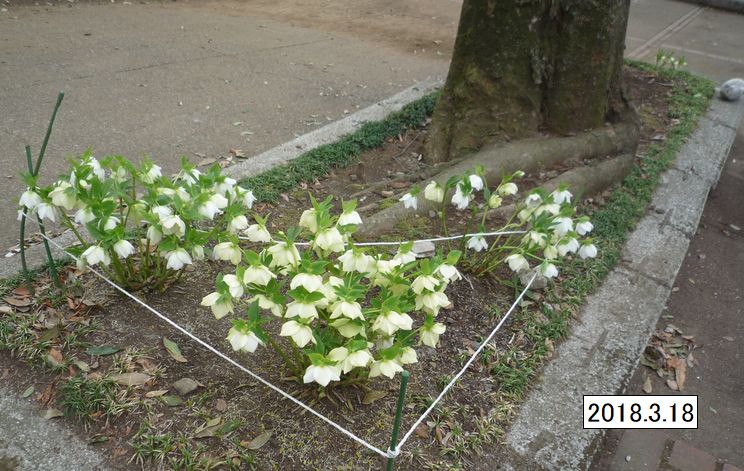
1. How should I get seeds ?
There are two types of strains: one is a strain that naturally swells
the pods and bears seeds if the flowers are left as they are (single-
flowered strains, etc.), and the other is a strain that does not bear
seeds unless artificially pollinated (pollen is attached to the tip of
the pistil). (double-flowered stocks, etc.). Pollinate to ensure seed.
About two months after flowering (pollination), the seeds inside the
pods will bear fruit, and on a dry, sunny day, the pods will crack
and the seeds will spill out.
In order not to spill the seeds, cover the pods with a tea bag when the
pods are swollen (around 1 month after flowering) and staple them in
place.
The seeds of Christmasroses are plump immediately after they break out
of the pods, but after four to five days they become dry and thin.
It is said that dried seeds do not germinate for 2 to 3 years (in fact,
they do not germinate the following year), so as soon as the seeds start
to spill out of the pods, cut them off together with the pods and harvest
them.
2. How should I store the harvested seeds ?
After harvesting the seeds, remove the pods and debris, keep them in tea
bags, and bury them in moist soil to prevent them from drying out. Keep
this soil from drying out.
Christmasrose seeds do not germinate immediately. Under natural conditions,
germination is possible only after the seeds have experienced the heat
of summer in a moist state, followed by the cold temperatures of winter.
3. What is the storage method to promote germination ?
Harvested seeds contain germination inhibitors and do not germinate.
In the preservation method that artificially accelerates germination,
germination is enabled by exposing the seeds to a temperature of 20°C
or higher for 2 months, followed by a low temperature of 5°C for 2 months
while the seeds are still moist. In this case, germination will be from
November to December, which means that the seeds will germinate 2-3 months
earlier than under natural conditions, and the growth will be accelerated
accordingly.
Immediately after harvesting (mid-late May) to the end of July, bury the
tea bag in the soil under natural temperature and keep it from drying out.
At the end of July, take it out of the soil, wash it with water, put it
in a plastic bag with moistened vermiculite (or water moss) and lightly
seal it. If you store this plastic bag in the vegetable compartment of
the refrigerator for two months, germination will begin and white roots
will begin to appear. Sow these seeds in the soil.
H. Sowing and subsequent management
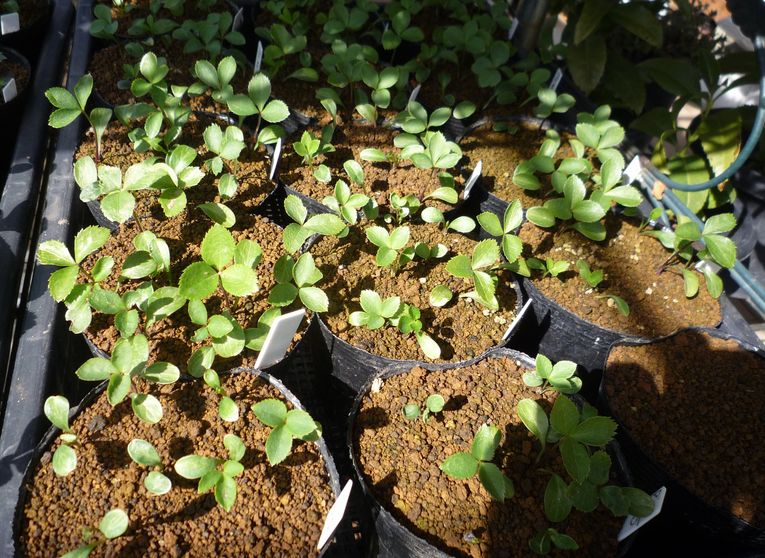
1. What is the specific method of sowing ?
Seeds that have been treated to promote germination are sown in 12cm
vinyl pots from late September to early October.
In a 12cm vinyl pot, put 60% to 70% of the soil (*note) containing some
fertilizer, and then spread about 1 cm of new Akadama soil on top, and
lightly water it.
(*Note) Akadama small soil 60% and ripe leaf soil (powder state) 40%
are mixed well and moistened with liquid fertilizer (1,000 times).
Spread about 10 seeds on top. On top of that, cover the soil with small
granules of Akadama soil about 1 cm, press lightly, and water thoroughly.
If the type of seed is different, even if it is only one grain, be sure
to sow it in a different 12cm pot. Put up a label (pencil writing) with
the name of the sown seed.
If fine soil such as black soil is used, moss will grow on the topsoil,
causing poor germination and making management difficult.
2. Where should I put the sown pots ?
Keep the sown pots in a warm, sunny place so that they do not dry out.
After seeding, germination is promoted at a slightly higher temperature
of 10-20°C until germination (after 1-2 months), and after germination,
it is managed at a lower temperature of 5-15°C. After germination, high
humidity and high temperature are likely to cause "koshiore" disease,
so be careful of high temperatures (20°C or higher).
The plastic pot has only one hole in the bottom, so depending on the
condition of the place where it is placed, the drainage may be too good
or bad. Arranging them on a flat colander or other well-drained object
will make subsequent water management easier.
3. How to water the planted pot ?
Check the sown pots daily. Drying is strictly prohibited, and if it is
completely dried, it will not germinate anymore.
If the topsoil is dry at the time of germination, the epidermis of the
seed dries up and cannot be removed, and it becomes like a match stick,
preventing the development of the two leaves and stunting the growth.
It is important not to let the topsoil dry out until the leaves have
fully developed. It's a good idea to water the topsoil daily.
4. Anything can be used as a seed-sowing pot, right ?
If the pot used for seeding is too small, the growing environment will
be harsh and management will be very difficult. Even when sowing 1 to
several grains, it is better to use a No. 4 pot.
Sowing a lot of seeds in a large shallow pot makes water management
easier, but when planting in a pot, the roots become tangled and easy
to cut.
I. Management after germination
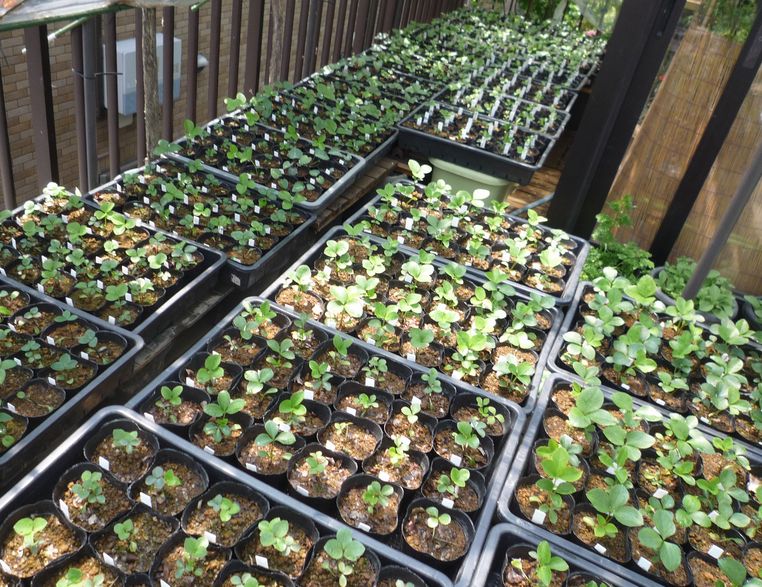
1. Where should I place pots after germination ?
Get enough sunlight. Even if you move the pot to a sunny place, expose
it to the sun. If the pot is exposed to the sun, the growth of roots in
that part will be promoted, so turn the pot from time to time.
"Futaba" is the only energy supplier at this time as solar panels.
Fertilizers that plants absorb through their roots are raw materials
that produce energy, not energy. Based on this raw material and
sunlight, energy is created in the leaves.
Seedling growth is proportional to the area of the foliage, so the role
of "Futaba" is enormous for the first year after germination. Therefore,
during this period, everything is managed so that "Futaba" grows healthy.
Too much fertilizer and too much temperature will ruin "Futaba". Let's
watch the growth without rushing.
2. How about watering after germination ?
Modesty is the rule. Apply generously after the topsoil is completely
dry. Instead of reducing the amount you do at one time, open the interval
you do.(Sometimes once every 1-2 weeks.)
3. What about fertilizer after germination ?
The principle is to "thin things sparingly". When the futaba unfolds,
apply plenty of 1,500 to 2,000 times liquid fertilizer (equivalent of 3
ingredients) instead of water. When one true leaf develops, apply
liquid fertilizer again with the same concentration as the first time.
If the leaf color is solid, it is a good sign.
J. Potting and subsequent management
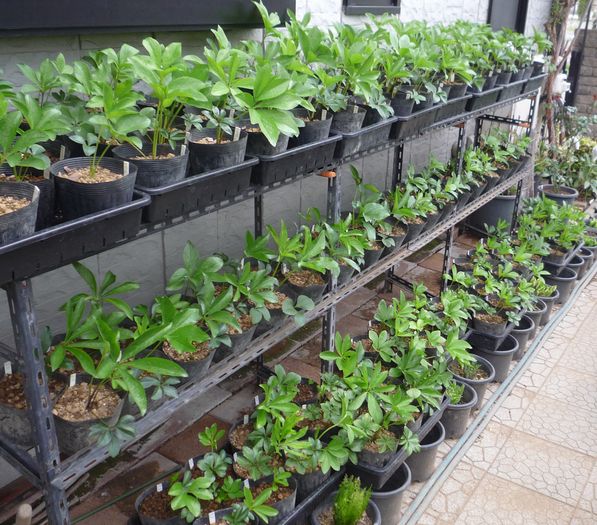
The process of digging up a seedling and planting it in a pot for
the first time is called "potting up".
It's a sensitive time to environmental changes, so treat it carefully
and gently. Do not dry out the roots.
1. When should i start potting ?
It is done when one true leaf has developed on average. At this time,
the roots are also branched and elongated, and they grow surprisingly
long compared to the above-ground parts. Seedlings that germinate late
and the true leaves have not yet developed (only small two leaves) will
be potted up in mid-March.
2. What kind of soil should I use for potting ?
Prepare the soil for planting in advance.
30% finely ground full-ripened leaf litter compost, 60% akadama soil
granules, and 10% black soil (or rice paddy soil) are well mixed,
moistened with liquid fertilizer (1,000 times the amount of the three
ingredients equally), and stored in a non-drying state. It is safer not
to use granular fertilizers such as chemical fertilizers.(This may cause
planting pain.)
3. What is the potting procedure ?
For seedlings to be potted, dry the soil thoroughly (from 2 to 3 days
before).
Hold the seedlings between your fingers, turn the pot upside down to
break up the soil, separate the seedlings one by one so as not to damage
the roots, and cover the roots with moist soil to keep them from drying
out.
Fill a 9cm (or 10.5cm) vinyl pot with about half of the above soil (it
will be easier to plant if you put it diagonally along the edge of the
pot). Carefully put a seedring in the pot and add the remaining half of
the soil. At this time, pay attention to the depth at which the seedlings
are planted, and plant so that the base where the two leaves are separated
slightly protrudes from the surface of the soil. The soil should only
be lightly pressed, not too hard. Water well after planting.
When handling seedlings, do not hold the stem (lifetime), but pinch the
Futaba (1 yeartime).
4. Where should I put them after potting up?
After planting, avoid frost and manage under the eaves that are exposed
to warm sunlight.
If you will be able to use a greenhouse without heating,it's better for
the seedlings.
5. How to manage after potting ?
The optimal growth temperature for potted seedlings is 5 to 15°C.
It is no problem that temperatures rise to around 20°C during the day.
On extremely cold nights (when the temperature is -4°C or below), put
them indoors without a heater (don't forget to get them out by 10:00 the
next morning) or cover them with a sheet to protect them from the cold.
6. What about seedling management after that ?
From March when the temperature rises, the stocks will become healthy
and new leaves will grow, so manage the seedlings according to the manual
(see the cultivation management page).
Seedlings become clogged with roots as they grow, so they are replanted
into larger pots twice a year, in September and March.
One-year seedlings in 9cm (or 10.5cm) pots that have passed the summer
will begin to grow new leaves in September, so transplant them into 12cm
plastic pots in mid-to-late September.
Two-year seedlings in a 12cm pot that have passed the winter will grow
roots in March and become clogged with roots.
